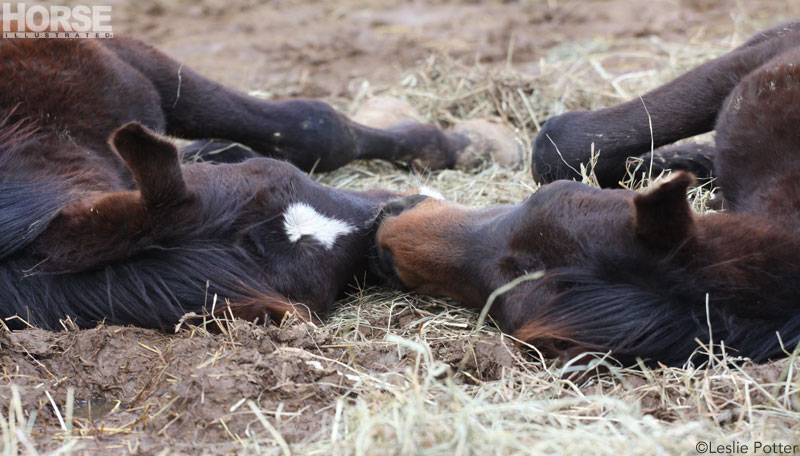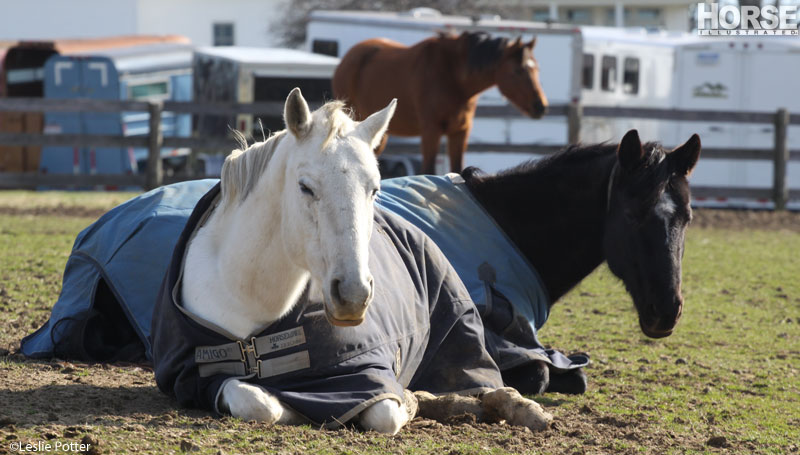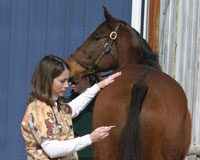
All horse owners know the familiar and somehow aesthetically pleasing outline of a dozing horse: one hind leg bent in relaxation while the other three legs are locked in place; head hung low; ears relaxed; lower lip drooping and maybe even occasionally twitching. We’re familiar with this image because horses doze a lot.
Why Horses Sleep Standing Up
A typical night as a horse will involve grazing, dozing standing up, and short periods of lying flat out to get some serious sleep. Although horses on average require roughly two to three hours of REM sleep a night, this deep sleep typically occurs in bursts of ten to twenty minutes at a time.
Lying Down to Sleep
Horses will only lie down and allow themselves REM sleep if they are completely comfortable in their surroundings. For horse owners, this means ensuring a quiet, safe haven for either stall or pasture. Here are a few tips to keep in mind when considering where your horse sleeps at night:
Size of the stall
Most adult horses, other than drafts or large warmbloods, can be comfortable enough to lay down in a box stall that is 12’ x 12’. Most horses will not lie down if they feel the space is too small, and for good reason. A horse that lies down and can’t get back up—either because the space is too small or the horse’s legs are too close to a wall—is cast. This may require expert help with professional experience using ropes to get the horse standing again.
Bedding
Obviously a bare concrete floor won’t do as a mattress, but just how deeply bedded should a stall be and with what? Straw bedding is adequate if it provides cushioning, insulation, and absorbency against the floor. The same can be said for shavings, unless a rubber mat is in place; if that’s the case, then enough shavings to provide absorbency are fine. If you need another reason to bed your horse snugly at night, capped hocks and capped elbows (joint swellings medically known as bursitis) can be caused by poorly bedded stalls.
Darkness
Turn off overhead stall lights in the barn at night. If lights are required to stay on for security, consider motion lights or strategically placed illumination that doesn’t shine into each stall. Just as artificial light can affect a mare’s reproductive system—which is how Thoroughbred breeding farms breed mares very early in the spring prior to the natural start of a mare’s cycle—it can also affect your horse’s sense of day length and interfere with normal sleep/wake cycles. Keep lights off or as dim as possible at night.
Peace and quiet.
Smaller barns don’t have to worry about this but at large training barns with hectic show schedules or busy breeding barns, there might be something going on at almost all hours of the night. These circumstances are the most common in which to see a horse suffering from REM sleep deprivation. If your horse lives at such a barn and you’re concerned about his sleep habits, consider where his stall is in relation to what’s always going on, be it next to an indoor ring, the tack room, the bath stall, the hot walker, or the driveway. If it’s possible to move him to a quiet end of an aisle, this might help.

Considerations for a pasture aren’t quite as demanding for a good night’s sleep. For one thing, size usually isn’t a consideration outdoors. Also, most horses are fairly content to lie down on grass or dirt. Instead, for pasture sleepovers, consider the herd dynamics. If there is a boss horse that is a known bully, your horse may not feel comfortable enough in the herd to lay down at night, depending on his position in the social pecking order. This is an especially important aspect to consider when introducing a new horse into a herd.
Protection from the elements is another aspect to consider in the pasture. Many horses can be found curled up on the snow in their comfy blankets, but excessive wetness may preclude laying down long enough to catch some decent shuteye. Make sure out in the pasture, your horse has access to a run-in shed if the environment necessitates it.
Also keep in mind that your horse may not sleep well when traveling. If you’re at a show or on the road for days or weeks at a time, be sure to help you horse catch up on his sleep as soon as he gets back home. Incorporating some of the tips above when out on the road can help as well.
Of course, there are some horses out there that can sleep through anything. Occasionally you might come across an unusual horse that has no issue with snoozing the hours away in the middle of the field or in his stall or just about anywhere. Such horses snooze so soundly that even us humans can become a bit jealous. With these horses, some of us might benefit from a few tips from them!
Liked this article? Here are others you’ll enjoy:
Ask the Vet: Deep Sleep
Feed Extra Forage at Night






I love to see all my horses sleeping in the sun light. When all are sleeping, everything around them is good. Lots on new information in this sleeping article.
One thing I love about my horse is that I know he feels secure because always after breakfast he lies down and sleeps the morning away to get his REM sleep. You can sneak up on him and he’s totally unaware. And if you wake him he just opens and eye and then goes back to sleep. Now that’s security!